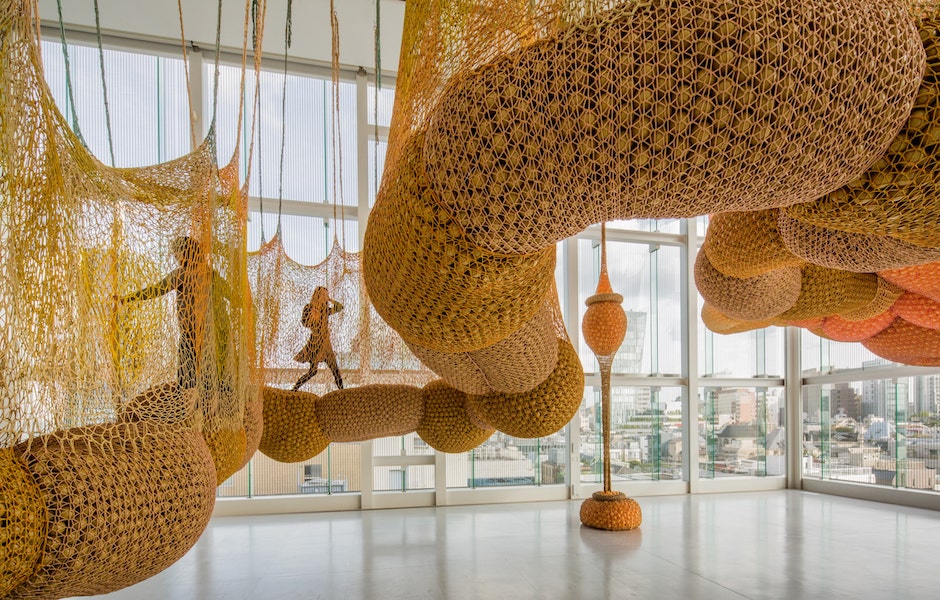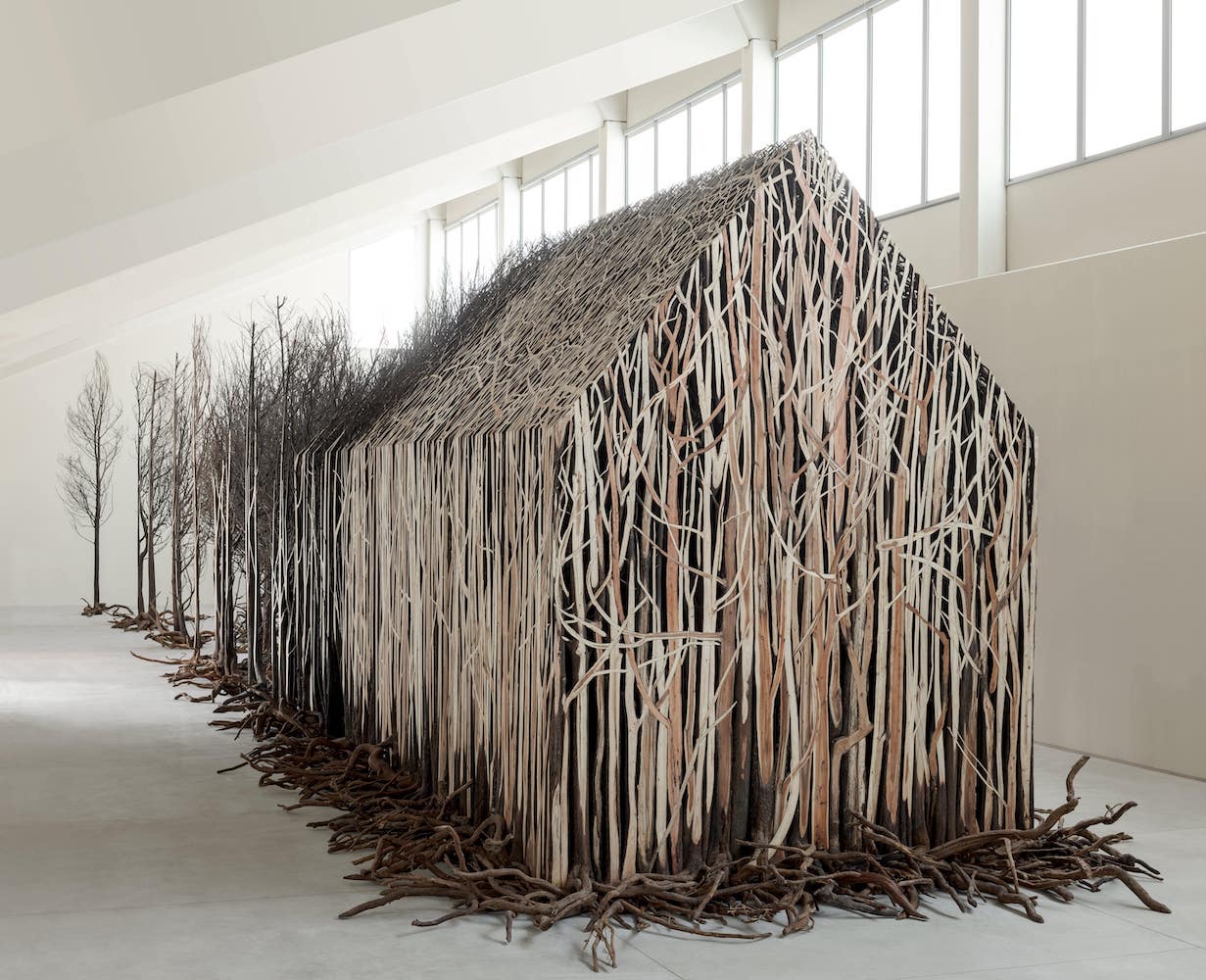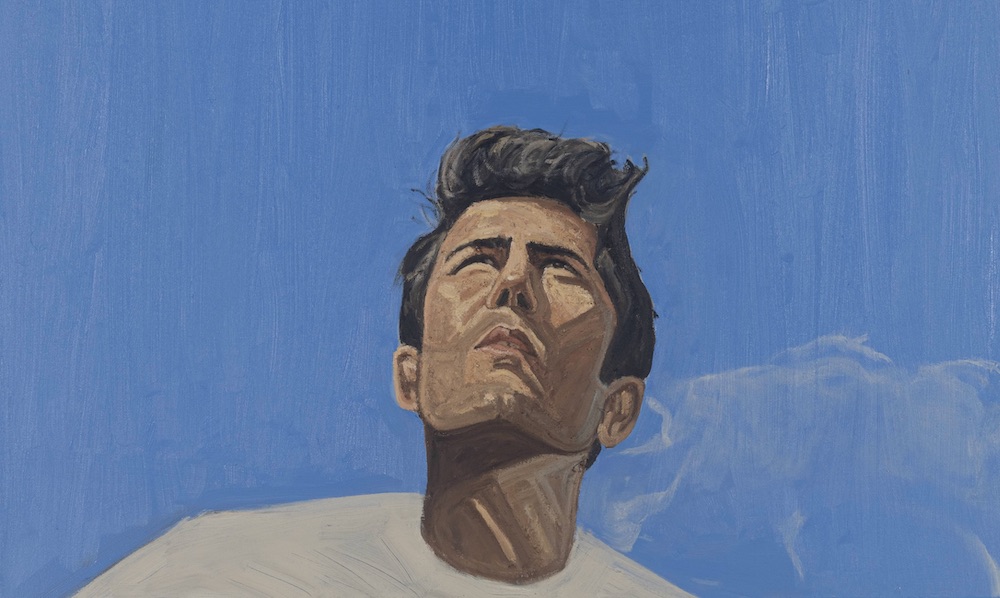Brothers Ramin and Rokni Haerizadeh met Hesam Rahmanian in the early nineties in Tehran, at an underground art class. Later, while building their creative career, they lived and worked in a place that was open to musicians, actors, writers, artists, poets, and the like. It was an alternative space some have compared to Warhol’s Factory.
Over the years, spending so much time together, the three naturally grew into a collective of sorts, fueled by collaboration with many outside, like-minded practitioners. Their subsequent move to the UAE has resulted in a flourishing practice that redefines the home in ritual and scope. They wake at the same time each day, taking in the sights and sounds of the morning, and discuss recent reads and discoveries. Each room of their home and studio—which boasts a library, cinema, and research center—offers a chance for activity and immersion. While some may consider it a prison of their own making, the Haerizadeh brothers and Rahmanian love how it exists somewhere between public and private.
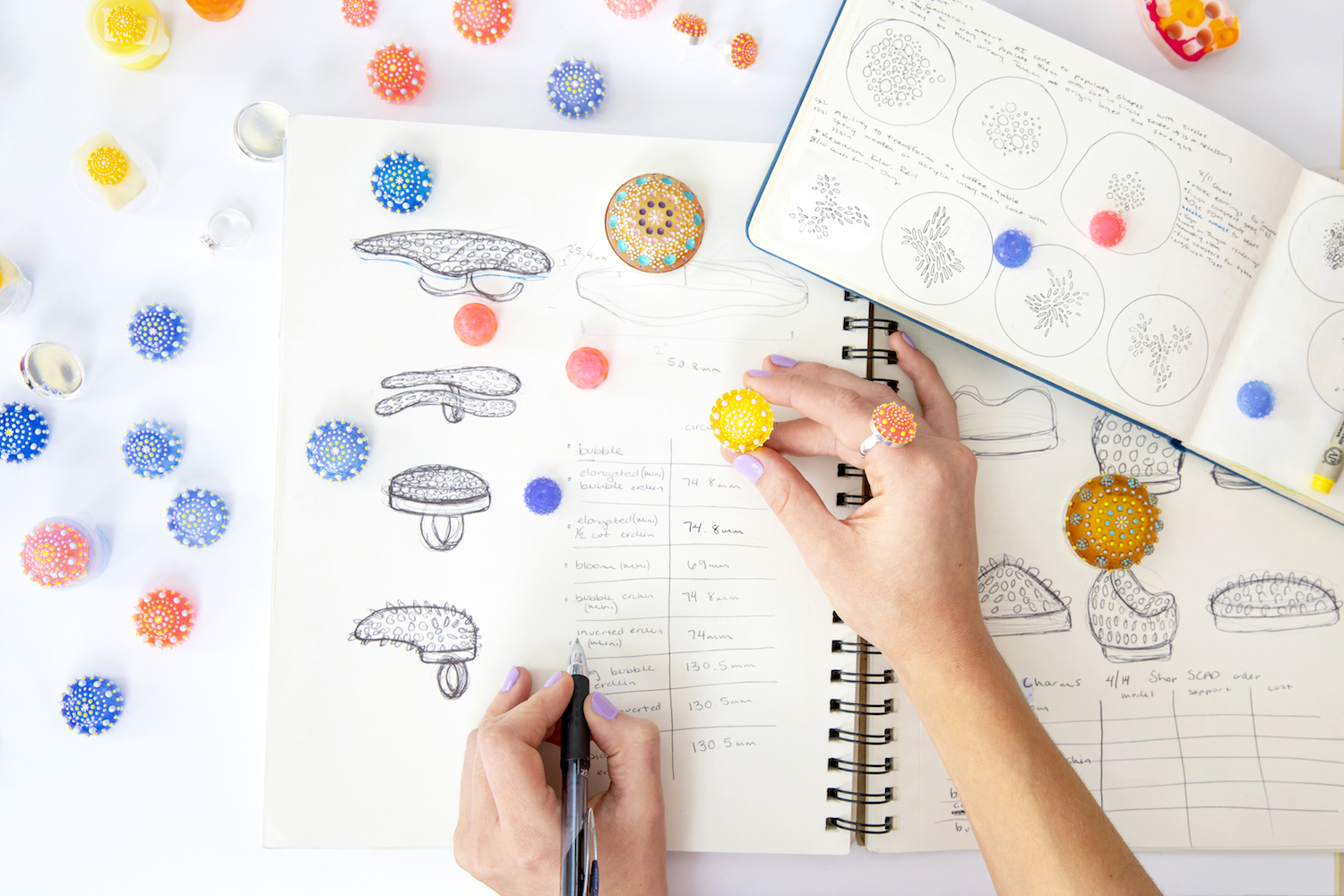 SCAD Savannah – Winter 2019 – SCAD+ – Process Documentation – Lot28 – Project by: Jocelyn DeSisto, BFA Jewelry (JEWL) – Forsyth House – Photography Courtesy of SCAD – Photography Courtesy of SCAD
SCAD Savannah – Winter 2019 – SCAD+ – Process Documentation – Lot28 – Project by: Jocelyn DeSisto, BFA Jewelry (JEWL) – Forsyth House – Photography Courtesy of SCAD – Photography Courtesy of SCAD
The trio’s home could be considered something like a sketchbook or notebook for projects, like “The Birthday Party” at the ICA in Boston (December 16, 2015–March 27, 2016), that include performance, installation, and video.
After hearing from the Haerizadehs and Rahmanian for our spring 2020 Art Issue, we recently checked in to see how the trio was doing during the pandemic. They shared the new video above, and said, “We made casually [it] with our phones on our daily activities/routines, including extracts from a poem by Mahmoud Darwish and an adaptation of The House is Black by Forough Farrokhzad as voice over. We have been privileged to be working and living together in quarantine all these years and continuing to do so. So, this past couple of months haven’t made so much effect on our living/working routine, though it has indeed brought us some challenges as it has for many all across the world!”
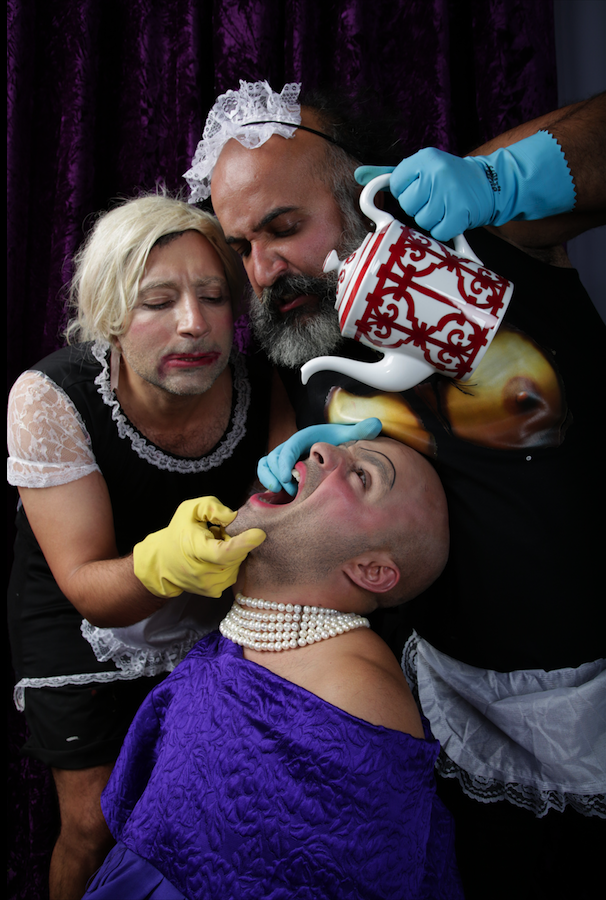 Photo by Maaziar Sadr.
Photo by Maaziar Sadr.
Whitewall spoke with the artists about breaking the rules and eating up boundaries.
WHITEWALL: Can you tell us the story of how the three of you first met, over 25 years ago, at art class?
RAMIN HAERIZADEH, ROKNI HAERIZADEH & HESAM RAHMANIAN: We met in the early nineties in underground drawing and painting classes when Iran was recovering from an eight-year war. It goes all the way back to the beginning of the revolution, Iran’s “cultural revolution,” 1980–83. This was when the academia of Iran decided to remove all Western and non-Islamic influences from the universities and implement their own ideology and political Islam into academies to keep things in line with what the revolution aimed to become.
Therefore, some teachers, philosophers, art historians, musicians who taught in universities or had just returned from studying abroad were banned from the universities, and the only way to keep their practices and make a living was by holding underground classes, which continue until today.
WW: How did you decide to come together as a collective in 2009?
RH, RH & HR: Becoming a collective wasn’t really a decision, and it did not start from an idea or expression of the same feeling, but, rather, and simply from being together; to work and live together. So, the word “we” doesn’t refer only to the three of us. It often includes other people from other fields of practice, like writing, engineering, theater, architecture, design, et cetera.
WW: You’ve described the beginning of the collective as something almost like The Factory. Can you tell us about that?
RH, RH & HR: While living in Tehran and trying to build a career in art, we had maintained an alternative space, with underground activities, where we kept the doors open to musicians, writers, actors, painters, sculptors, and like-minded people and practitioners. We provided free studios to artist friends who came to Tehran and couldn’t afford the capital while attending the university. As a result of these gatherings, many projects were realized through collaboration, even if they turned out to be ephemeral. However, none of these collaborations led to a firm collective, due to the transient moment of life we were living.
So, the core of these gatherings and togetherness was similar to Warhol’s Factory and his space as one of the inspirations for our later achievements in becoming a collective that continues to contract and expand by including people and friends from different walks of life, but artists at large.
WW: You then moved from Tehran to Dubai. How did your practice evolve or change once you moved to Dubai?
RH, RH & HR: Our practice flourished in the UAE as we have few limitations in expression. We have practiced and experimented with almost no boundaries and stayed affirmative like the country is in itself. We find ourselves happier to work in a place where our work is appreciated, and we can continue our practice without unnecessary disruption. The best thing about our experience here is the forward-looking approach in the art and, consequently, the art scene. In such an environment, art can have an important place in helping build the society, by highlighting the best practices, and avoid some of the mistakes made in the past.
The biggest challenge, as it would be in any other place, is to search not for what fits in what has been predefined as “art,” but for something that breaks the rules and creates a new understanding of our time. The art communities have been welcoming and supportive in trying new experiences.
WW: Can you describe your home in Dubai, where you all live and work together? What is your day-to-day routine?
RH, RH & HR: After relocating to Dubai, we tried to redefine home, which in itself has been a ten-year project incorporating people and friends from other practices. So we started by a self-imposed discipline, starting from sunrise and following a repetitive ritual, which also has certain flexibilities. We have replicated a version of today’s cities in our house and decided to create an alternative environment in which we have more power over the way we plan our lives. To many it may seem like a prison, but we like this prison. We wake up at the same time as the birds in the garden and match our activities to the movements of the sun. There are discussions every morning about the most recent book we’ve read, the film we’ve watched, that are always directed back toward our work at hand. In every corner of the house and garden we have an activity station that we stop at on different days. The home/studio works as our notebook for upcoming projects. It is a landscape that constantly changes itself.
In addition to that, we have an extensive library, a cinema, a research center, and residencies inside the house. Artists and friends come over to watch a movie, to cook, borrow books, discuss and exchange ideas, or work on individual projects as well collaboratively.
WW: For a number of projects, like at the ICA in Boston in 2015 or recently at the Louisiana Museum in Denmark, you mimic that home /studio routine and create installations. Can you tell us about that process?
RH, RH & HR: Our exhibitions are not really trying to mimic our home/ studio. However, our home/studio has been an ongoing project in itself that’s been gradually building up over the past decade. It is something between a public and private space. It is a notebook that, for every project, it collects its own objects and materials in order to create its own environment.
Though, as for the ICA Boston, for example, we were revisiting the play Birthday Party by Harold Pinter, and rereading it constantly over and over again until it became some sort of a ritual. When you keep repeating something, you reach a point of automation and arrive in a new field of the mind. In this case, the text itself was very important to us, rather than the play.
The other source of inspiration for the realization of the floor at the ICA is Zār, which is a pagan healing ritual, originally from Ethiopia, that stretches all the way to Northern Africa, the Gulf region, and beyond, and it is still practiced in many places. It is based on ecstatic dancing and an obsessively repeated series of movements that can last for hours. Breathing and the wind, which both share the flow of air, are two very important factors in this ritual. They believe it’s a certain kind of disastrous wind (Zār) that possesses people and the dance and breathing—as the basic feature of life—have a healing power.
When doing the Birthday Party, a lot of destruction came into the process, as what the dastgah(s) tried to build ended up falling or breaking or being destroyed. We didn’t put much emphasis on this issue at the time, until the video of the ISIS destroying Mosul came around and we suddenly saw a resemblance between our actions and theirs. This raised the question of what the difference is between two different forms of destruction. As a result of this, we started working on the video and “Big Rock Candy Mountain” moving paintings were born.
WW: How do you balance the collective practice and the individual practice? How does one influence the other?
RH, RH & HR: We are three distinct individuals who work together as a collective and often include other people and friends into our practice, but we each also hold our individual practices, so we are very much conscious of parts. In fact, everything in this world is interconnected with everything else and nothing could exist on its own. It is just a matter of recognizing that interconnection when we are practicing as individual artists. It is quite easy to learn that authentic art is authentic when it is done by one person, but there is always someone behind it—whether that someone is a partner, artist, or a friend. We are not stingy in sharing our achievements. Either individual or collaborative, we share all of our efforts with each other. For example, sometimes one gives an idea and the other two executes. Or one doesn’t do anything but all three take the credit.
WW: In the spring of this year, you’ll be participating in the Sydney Biennale. Can you tell us about your plans for the biennale?
RH, RH & HR: For Sydney Biennale 2020, we’ll be showing one of our moving paintings, From Sea to Dawn. In addition, working with the collection of the Powerhouse Museum.
“Moving painting” is a term we use to refer to a series of single works on A4 paper combined to make the frames of an animation. Each image is a still, which is painted and drawn on and then ordered into a sequence to create a video animation: These works focus on some of the most urgent issues of our time.
The preparation for the moving paintings starts by watching and gathering already existing news footage or videos that are found on YouTube, Vimeo, or from other sources. Then we start putting the collection of videos together and editing them until we reach a desired narration and length for the project. Then the video is printed out as individual frames. After numbering every frame and organizing them into groups, we spread them all on long makeshift tables and just like Chaplin’s Modern Times, robotically and repetitively, as if working on assembly line, we go through segments of the video, each one of us leaving a trace on every frame. Once finished, we scan them all back into the computer, reorder them on the timeline, and finalize them into a moving painting.
In classic painting, the viewer comprehends a painting instantly in a single frame, with zero movements (time) and experiences the traces of one body. We call these animations “moving paintings” because they are made of single frame paintings and tracing of the movement is not important the way it would be in classical animation.
As for the Powerhouse Museum, we are using objects from the museum’s collection, incorporating and disorganizing artifacts that take a sweeping arc across themes of grief, body, and healing.
WW: You’ve also described your work as a way to try to rewrite the history and response to the boundaries that have been put on you. Why do you see that as the responsibility of the artist?
RH, RH & HR: Our aim as artists is to record the time we are living in. So, for us, our projects are to focus on the most current issues of our time. We can always take our own map from the debris of the history and use it to construct our own. Same with the limits and boundaries, they are all transient. As artists you can always eat up the boundaries and turn them into conditions of the next achievements.







